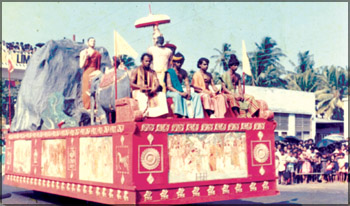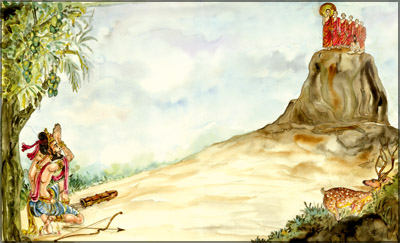Poson celebrations
Who was Mahinda Thera?
Mahinda Thera was the son of Emperor
Asoka, also known as Dharmasoka, who came to the throne of the Maura
kingdom in 268 BC. His mother was Devi, a princess living in Vidisa.
Emperor Asoka had five wives, and six children. Mahinda and Sanghamitta
were the children of Devi.
Asoka was anointed king 218 years after the parinibbana of the Buddha
and in these two centuries, the Sangha
|

A statue of Mahinda Thera presented from abroad.
|
had split into various sects, each sect claiming what they followed
and preached was the true Dhamma.
Conditions had got so bad that a council of learned and pious
bhikkhus was held, presided over by Moggaliputta Tissa Thera and under
the king's patronage.
At the conclusion of this council, the third since Buddha's passing
away, those bhikkhus who held views that the Buddha didn't preach and
followed practices that the Buddha disapproved, were expelled and the
order (saasana) cleansed.
Something else also happened after this third council. It was a
landmark in the history of Buddhism. Emperor Asoka decided to send
missionaries to nine other countries to spread the Dhamma. Some of those
countries were, Swarna Bhoomi (Myanmar), Kashmir, Gandara (part of
Punjab, Pakistan), Himalaya and Yona (Greece). The king's own son
Mahinda, was picked to go to Lanka. He was a bhikkhu and an arahanth by
then.
Mutasiva was the ruler of Lanka at that time. He was very old and it
was the view of both Moggaliputta Tissa Thera and Emperor Asoka, that it
was not the best time to spread the Dhamma in Lanka. So Mahinda Thera
went to Vidisa where his mother lives, and bided his time until King
Mutasiva passed away.
Mahinda Thera didn't have to wait long. When news reached Vidisa that
King Mutasiva had passed away and his son Tissa was on the throne,
Mahinda Thera decided the time was ripe and collected six other bhikkhus
to go with him to Lanka. He also had with him an Upasaka named Bhanduka,
perhaps to minister to their needs. Legend says that this party left
Vidisa and appeared on the cliff on Missaka hill in Lanka.
This is one of the miraculous powers acquired on becoming an arahant.
Bhanduka Upasaka and the samanera (novice) Sumana would have been
transported through the miraculous powers Mahinda Thera and the other
four bhikkhus-Uttiya, Ittiya, Sambala and Bhaddasaala - had.
The meeting with the king on the grassy plain at the foot of the
cliff has been explained in the next pages in this issue. Mahinda Thera
and his companions went to Anuradhapura the next day and had a meal at
the palace, and preached to the men and women of the palace, the Peta
Vatthu and Vimana Vatthu which explained how one's good deeds
and bad deeds determined one's next birth, as a peta or as a deva.
The Thera was in Anuradhapura for about three weeks, preaching to the
crowds that came to listen to him and returned to Missaka hill to spend
the Vas, the three-month retreat during the rainy season.
This hillock was Mahinda Thera's home for many, many years, so the
hillock got the name Mihintale - the plain of Mahinda. But before that,
Mihintale was known as Cetiya pabbata/cetiya
giri. Pabbata and giri mean rock or hill. This was because
many shrines (ceti) were built on this hill. The cave used by Mahinda is
known as Mihindu
|

Mihindu Perehera
|
Guhava - cave of Mahinda.
It is customary for a bhikkhu to receive the Upasampada at age 20. If
Mahinda had received the Upasampada - higher ordination at age 20,
scholars say he must have been about 32 when he came to Lanka. He was 80
years when he passed away.
So, he had spent half a century, less two years, serving the people
of Lanka. By then, King Devanampiya Tissa had passed away and his
brother Uttiya was on the throne. It was in the eighth year of Uttiya's
reign that Mahinda Thera passed away and his body was cremated with all
religious rites with the king taking the lead.
Poson is the season when the Buddhists pay him their respect. Next to
Vesak, Poson is the most important full-moon day, in the Buddhist
calendar. It is on this full-moon day that devotees flock to Mihintale
to pay their respects to this great man, whose coming to Sri Lanka, was
the spiritual conquest of the island. It was what Mahinda brought to
Lanka and did, that gave our country an identity as a Theravaada
Buddhist country.
Many Mihindu peraheras are held in various parts of the country in
his honour, some villages and small towns put up pandals at Poson-depicting
the events connected with his arrival and meeting with the king.
Among the many boys' schools named after him, the most famous, of
course is the college in Galle, at which port, Col. Olcott landed. As
you may be knowing, it was Col. Olcott who gave the lead and the push to
start Buddhist schools.
Sumana Saparamadu
The meeting on the hill
It gave the country an identity
It was the full moon Poson day in the
month of Jetta or now June. King Devanampiyatissa declared the day to be
a holiday. People taking time off their daily routine spent the day in
outdoor sports or water sports.
The king went out hunting. Hunting was from ancient times until very
recently, a royal sport. They went hunting for pleasure, not to secure
food as the poor did.
The king went with his men to Missaka Pabbata, a hillock covered in
shrub jungle about five or six miles to the east of Anuradhapura, the
capital. Seeing a deer in a thicket, the king chased him, but the deer
was too swift for the king.
It was at the foot of the cliff that the king saw the deer at close
quarters, and as the king was about to twang his bow, someone called out "Tissa, come here."
his bow, someone called out "Tissa, come here."
Flabbergasted (very astonished), the king dropped the bow and arrow.
"Who called me by my name?" He looked right and left, and up. Then he
saw a figure dressed in yellow standing on the cliff. By his miraculous
powers, Mahinda Thera had made his companions invisible.
Unable to speak because of the shock of hearing someone call him by
name - (no one dared call the king by name), the king stood staring at
the stranger for a minute or two.
Recovering his speech, the king asked "Who are you?"
Then the Thera, making his companions visible, said;
Samanah mayam
maharaja
Dhammarajassa saavakah
We are sramanas o, king, disciples of the Dhammaraja (Buddha)
Tameva anukampaya
Jambudeepa idaagatah.
Through compassion for you we came here from Jambudeepa.
Mahinda Thera came down from the cliff top, followed by five bhikkhus
and Bhanduka Upasaka, to the grassy plain below. Seated there on the
grass in the shade of a mango tree, the king and the Thera had a long
discussion.
The purpose of the Thera's visit here was to tell the king of the
Buddha Dhamma, and make him accept the Triple Gem - Thisarana (the
Buddha, Dhamma and Sangha) as his refuge that is to formally become a
Buddhist.
But before taking up this special mission, the Thera wanted to make
sure that the king would be able to understand the Dhamma. So, he put
some questions to the king to test his intelligence, his ability to
think clearly, and reason out anything. This Intelligence Test is given
as a box in this page.
Satisfied with the king's intelligence, the Thera preached the Chula
hatthipadopama sutta - the minor sutta of the semile of the elephant's
footprint.
The sutta opens with the indirect warning not to rush to a conclusion
on the first evidence - a large footprint is not necessarily that of a
great elephant. Then the sutta goes on to explain what the life of a 'samana',
a monk, is and how one becomes a Buddhist.
Mahinda Thera may have decided on this sutta for his first sermon to
introduce himself and his companions and to dispel any suspicions the
king had about them, strangers suddenly appearing on a hill top from
nowhere.
After the sermon the king said "henceforth, the 'thisarana' will be
my refuge." When the king said the thisarna will be his refuge in
future, that was the formal acceptance of the Buddha Dhamma as the state
religion. This happened about 243 years before the Christian era began
and since then, Buddhism has been the 'main' religion for 2,550 years.
This meeting of the king and the Thera (on the grassy plain now known
as ambasthala, the plain of the mango trees), was one of the most
fateful events in our history and it is what gave the country and the
people an identity and a national consciousness, which "centuries of
warfare or the attacks of modern commerce could not destroy."
As the king and Thera sat there conversing, food was brought for the
king. He invited the Thera and his companions to share the meal. Mahinda
Thera declined the offer telling the king that they observed the rule of
not eating after the prescribed time, which is 12 noon.
Before leaving for Anuradhapura, the king invited the Thera and his
companions to a meal in the palace the next day, Mahinda Thera accepted
the invitation.
The suspicion the king got when he saw the monks on the cliff top was
still lingering in his mind. So before he left, he called Banduka
Upasaka to a side, and asked him, "Are these really human beings or are
they some celestial beings who have suddenly descended here?"
Banduka Upasaka convinced him that they were indeed human and the
King went away with peace of mind, looking forward to meeting them again
next day.
Sumana Saparamadu
****
Fact file
The Mihinthale
* The "Missaka Pabbata" is situated eight miles east of Anuradhapura,
close to the Anuradhapura - Trincomalee Road. This mountain is 1000 feet
in height.
* From ancient times, a large number of huge steps were constructed
to climb Mihintale.
* It is stated that King Devanampiyatissa constructed a vihara and 68
caves for the bhikkhus to reside at this place.
* It is believed that King Suratissa may have built Kantaka Chetiya.
* Ambastala Chetiya is situated on the plain close to the peak of the
mountain, and is said to have been built by King Makalantissa.
* The large stupa known as the Maha Saya, the base of which is 136 ft
in diameter, on the summit of the Mihintale hill, was built by King
Mahadathika Mahanaga (7-19 AD)
The Intelligence Test
To make sure that the king was intelligent enough to understand the
Dhamma, Mahinda Thera asked him some simple questions, which are given
below. Reading them, you might think how stupid these questions seem to
be.
Read them carefully and you'll see that they are NOT as simple or as
stupid as they appear. To answer them, you need to think clearly and
sensibly.
Here are the questions of the first Intelligence Test on record.
Q: What name does this tree bear, O
King?
A: The tree is called mango.
Q: Is there another mango tree besides
this?
A: There are many mango trees.
Q: Are there any trees other than this
mango tree and other mango trees?
A: There are many trees Sir, but those are not mango trees.
Q: And are there, besides other mango
trees and those trees which are not mango trees, yet other trees?
A: There is this mango tree, Sir.
Thou has a shrewd wit. "O ruler of men" said the Thera.
The catch was in the last question.
The king had thought carefully and answered correctly and quickly. |
